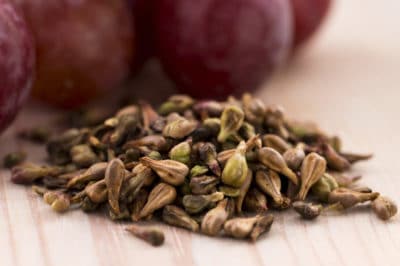Pick your seeds.
There are many types of grapes, depending on your plans for the fruit. Do you intend to eat your grapes, make jams and jellies, or make wine? Decide on the type of grape you want to grow and then prepare them for planting.
Prepare your seeds.
Wash your seeds, particularly if you’ve taken them from fresh grapes; remove any pulp from them. Once the seeds have been cleaned, soak them in distilled water for 12 to 24 hours.
Stratification is necessary for your seeds to germinate properly. This process mimics the experience of seeds laying in the cold ground all winter. To stratify, follow these steps, beginning in December:
- Fill an airtight container or storage bag partway with moist peat moss, sand, or vermiculite; you can use wet paper towels if you want.
- Place the seeds into the prepared container and cover with about half an inch of potting soil or other growing medium.
- Keep your seeds in a steady temperature of 35-40°F (1-3°C); a refrigerator is probably your best bet. Do not allow your seeds to freeze.
- Keep the seeds cold for two to three months.
Pot your seeds.
In early spring, remove seeds from the refrigerator and plant them in containers; if you are using large pots, plant sees about 1 ½ inches (4 cm) apart.
Seeds need to be kept warm. Daytime temperatures of about 70° F (20°C); and night temps of 60°F (15°C) are good. Keep the soil moist, watering lightly whenever the surface seems dry. Your grapes will sprout in about two to eight weeks.
When your sprouts are about three inches tall, move them to larger pots; one sprout per 4 inch (10cm) container. These seedlings should be kept indoors and warm until they are about 12 inches (30cm) tall and have strong roots and several leaves.
Plant your seeds.
At this point, your seedlings can into the ground . Be sure the ground you choose is well drained and that you have trellises in place for the plant to grow on.
About two weeks after planting, you can lightly fertilize your plants with magnesium, phosphorus, and potassium products. Epsom salts, bone meal, and greensand are good organic choices for this. You can also use manure (rabbit, steer, or poultry), to feed your plants. Do this early in the year, January or February.
There will be additional annual maintenance, such as pruning, to perform every year. Failing to attend to these chores will result in damaged, overgrown, or unproductive vines, so be sure to plan for them!
